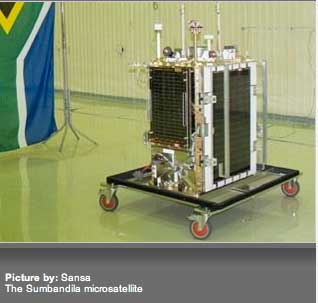
South Africa’s Sumbandila Earth observation microsatellite is not totally dead. “We still ‘see’ Sumbandila, monitor the solar panels, check the battery levels and now and again receive its signal,” South African National Space Agency (Sansa) Space Operations and Earth Observation MD Raoul Hodges told Engineering News Online.
“Radio hams are still using Sumbandila to relay messages. The satellite is not completely inactive but we can’t switch on the imager and it can’t be used for Earth observation or the downloading of data. But it is still useful as a training tool.”
Hodges is seeking to preserve expertise gained with the Sumbandila programme. Sansa’s Space Operations division (while still the Satellite Applications Centre of the Council for Scientific and Industrial Research) set up a Mission Control Centre to operate the locally-designed and built microsatellite.
“I’ve taken those skilled staff and moved them to other units which do similar work, so we don’t lose or diminish our mission control expertise. We’re upgrading the Mission Control software, as we’re convinced that there will be future [South African] satellites,” he said.
Sumbandila still has about 30 percent of its fuel left, which, in theory, could be used to boost the spacecraft to a higher altitude and extend its orbital life. In practice, it is uncertain if the satellite would actually respond to commands to fire its thruster. Sumbandila was planned to survive for only three years.
Space Operations is, of course, heavily involved in supporting many satellites and other spacecraft from other countries. “Some interesting birds are coming over the horizon,” enthused Hodges, referring to new satellites that will be launched this year. “As a space agency, we have to be on top of the next Earth observation satellites, their sensors, what they can do, what we could and should buy into.”
Article by Keith Campbell available at Creamier Media's Engineering News .

